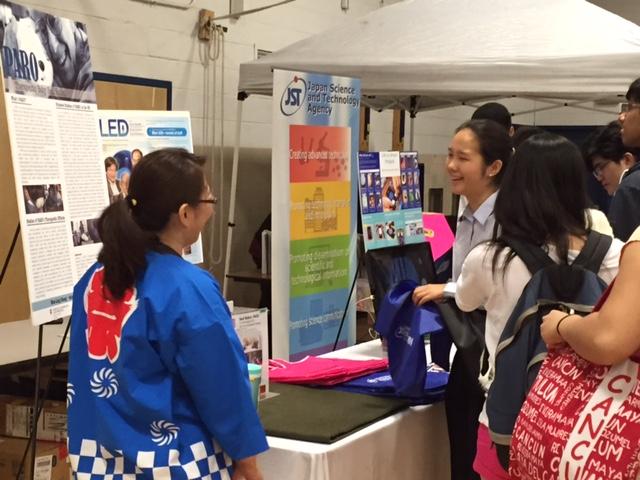tjSTAR culminates yearlong student research
Senior Bridget Park talks to one of the representatives of AIST, a Japanese research facility that developed Paro, a therapeutic robot.
June 13, 2015
On June 9, Jefferson held its annual Thomas Jefferson Symposium to Advance Research (tjSTAR), in which seniors and freshmen presented their year-long tech labs, mentorship and Integrated Biology, English and Technology (IBET) research projects. Professionals in science, engineering, technology and mathematics (STEM) fields gave interactive presentations and hosted discussions and panels, providing a glimpse into the future of STEM and offering advice.
“It was a great experience to present my project in front of my peers as well as an excellent opportunity to learn what others are currently focusing on,” senior Winston Ou said.
This year’s keynote speaker was Paul Andersen, most famously known for his YouTube channel, Bozeman Science, that he launched five years ago. Andersen, a high school science teacher in Montana, breaks down and explains scientific topics in his videos, helping many Jefferson students when they had difficulty understanding concepts in biology, chemistry and physics. In his keynote presentation, Andersen addressed topics like passion and drive.
The symposium began with Anderson’s keynote, following with five sessions of presentation blocks that each student selected prior to the symposium through an online registration process. The tjSTAR planning committee invited professionals and alumni in various STEM subjects for special speaker sessions, including Naoko Yasuo of Japan Science and Technology Agency in Silicon Valley, Donna Woodall of Microsoft and Sung Nguyen of Google.
Throughout the day, students had the opportunity to attend the Displays and Demonstrations session held at Gym 2, where they could watch documentaries produced by Chemistry Humanities (CHUM) students and familiarize themselves with unique STEM-oriented organizations, such as the NASA Goddard Space Flight Center and Ntrepid.
“It was overall pretty interesting and cool to see how STEM is relevant in the ‘real world,’” junior Kathy Jiang said. “I really liked NTrepid’s presentation and how they talked about their unique method of virus prevention.”
The symposium primarily consisted of senior research lab presentations and freshmen IBET project presentations. Seniors from 14 different labs, including Astronomy and Astrophysics, Chemical Analysis and Oceanography and Geophysical Systems, presented their individual research to a small audience and fielded questions regarding what they learned.
“It was a strange experience, knowing that I was presenting my last research project in high school,” senior Brian Juntilla, who presented his research for the Chemical Analysis Research Lab. “But I thought it definitely summed up four years at TJ perfectly and I am able to go out satisfied.”
Likewise, freshmen presented their year-long research, which also involved statistics and data collection, and answered relevant questions.
“My favorite part of tjSTAR was presenting my IBET project in front of my peers and parents,” freshman Niharika Vattikonda said. “My group worked all year on studying the effect of the strength of an electromagnetic field on E. Coli growth, and those 13 minutes were an amazing finale to our IBET project.”
Students felt that tjSTAR provided a unique opportunity to not only present research but also learn from peers in school and other adults around the world.
“tjSTAR can be both a great experience or a snooze, it all depends on what you sign up for,” sophomore Steven Li said. “tjSTAR had great presentations and demonstrations in the tech labs, as well as a great keynote speaker.”






